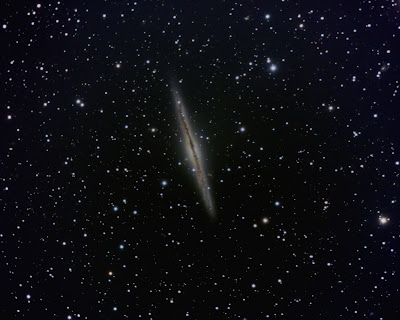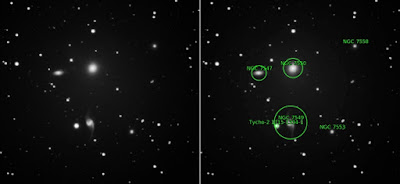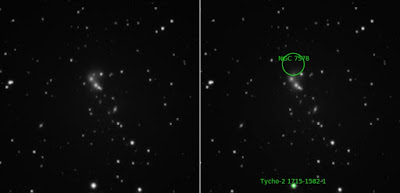It's possible to get caught up in an observing list and work on it to the exclusion of everything else. That's pretty much what I did while working on the Bright Nebula list, particularly when I got to the point of having a dozen or so items to go. Everything was dedicated to completing the list to the point that it dictated what gear would be used at star parties and how my time would be spent.
Perhaps a saner approach is to slow down and mix in non-list items for imaging along the way. That's what I did the other night, and it worked out well.
Lately I've been traveling to a friend's home north of the Twin Cities and we've been observing and imaging together. His sky (suburban-rural transition) is much darker than mine (inner red zone urban) and his gear is definitely better than mine and mounted in an observatory. I set up just as if I'm at a star party, polar align, and get to imaging. Then I'm free to help him while he works on reacquainting himself with the process of imaging--he's been inactive for several years--or hunts down deep sky objects with his 16" go-to Dob. It's the best of both worlds for me to have the benefit of his sky and telescope.
And just as at any star party, it's nice to have someone else around to talk to.
Plus at 4 A.M., I have a nice soft sofa to crash on instead of a tent!
Last Sunday was my latest trip to his place for imaging, and we succeeded in getting his imaging system working for the most part. His autoguiding wasn't working, but he's implemented a fix for next time based on what I use.
I had no specific plans for the evening other than imaging Arp galaxies for that Astronomical League list and maybe during the A.M. of switching to a planetary. My friend had his own list of favorites he was eager to observe using his big Dob and we looked at some of those. About the time I was wrapping up with my second Arp he mentioned NGC 891 and showed my his first light frame. In case you don't know 891, it's a large edge-on galaxy in Andromeda. It's cut in half by a dark dust lane dotted with bright knots and has a rather large and distinct nuclear bulge. In other words, it's pretty.
To some extent imaging is all about pretty, and after all the "bright nebula" imaging in monochrome I decided I wanted to make an image in color. My friend's suggestion of 891 is all I needed to drop my list plans for the rest of the evening and try to make something pretty. Here's the result:
 |
| NGC 891 |
(Details
here at Astrobin.) Not a perfect image, but I'm happy with it, and glad I opted to give it a try instead of doing more list imaging!
The early imaging was mundane Luminance only. The target galaxies were so small that color was basically a waste of time. Here's what I mean:
 |
| NGC 7550 (Arp 99, Hickson 93) |
 |
| NGC 7578 (Arp 170, Hickson 94; Note the plate solving error) |
These two bring my Arp count up to 12 compared to my planetary at 13. I'll probably add a couple more monochrome Arps next time out to make the lists even in terms of percent completed and then go off-list again!






